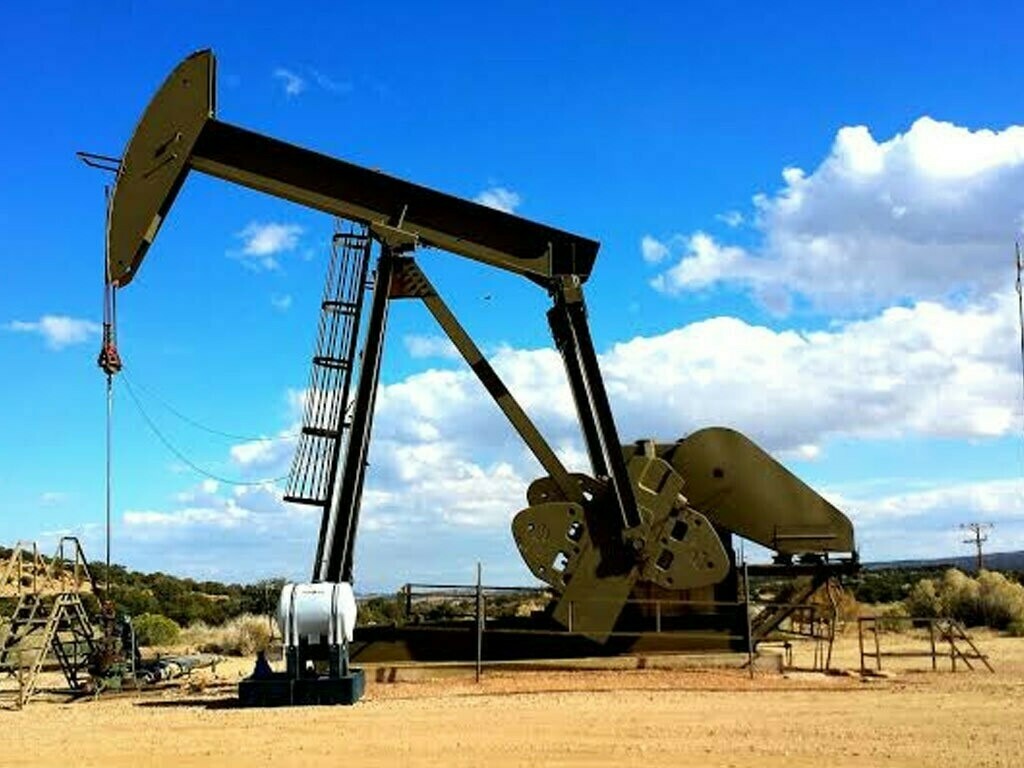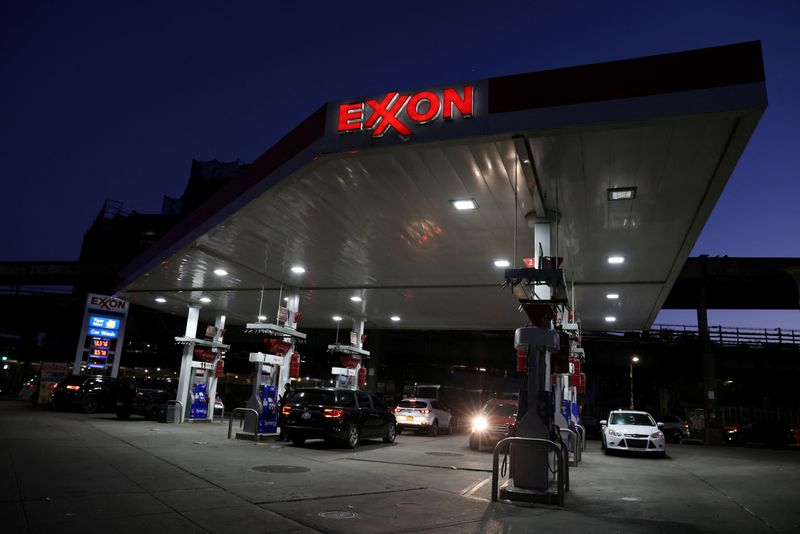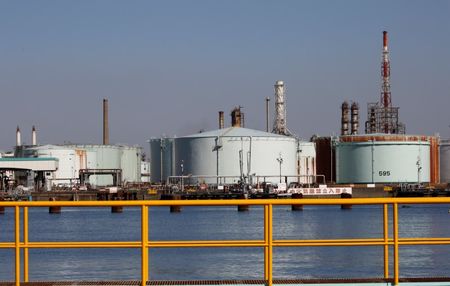Commodities
Oil extends losses as economic slowdown concerns return

Oil fell for a second day on Wednesday as concerns over global economic headwinds deepened, erasing the price gains booked after top crude exporter Saudi Arabia’s surprise weekend pledge to deepen output cuts.
Brent crude futures were down 56 cents, or 0.7%, at $75.73 a barrel at 0705 GMT. The U.S. West Texas Intermediate crude futures fell 52 cents, also 0.7%, to $71.22 a barrel.
Both benchmarks jumped more than $1 on Monday after Saudi Arabia’s decision over the weekend to reduce output by 1 million barrels per day (bpd) to 9 million bpd in July.
“The fears of recession, as more and more sombre economic readings point towards a slowdown, have kept a lid on oil prices, eroding all OPEC+’s efforts to keep prices afloat,” Priyanka Sachdeva, an analyst at Phillip Nova, said in a note.
U.S. gasoline inventories rose by about 2.4 million barrels and distillates inventories were up by about 4.5 million barrels in the week ended June 2, market sources said on Tuesday, citing American Petroleum Institute figures.
The unexpected buildup of fuel stockpiles raised concerns over consumption by the world’s top oil user, especially as travel demand grew during the Memorial Day weekend.
Meanwhile, the U.S. Energy Information Administration (EIA) said on Tuesday that U.S crude oil production this year would rise faster and demand increases would cool compared to prior expectations.
“The market has digested the news of Saudi’s production cut and investors are now reluctant to take a large position because of mixed economic forecasts and indicators in the United States and China,” said Hiroyuki Kikukawa, president of NS Trading, a unit of Nissan (OTC:NSANY) Securities.
China’s official data showed on Wednesday that its exports shrank much faster than expected in May and imports fell, albeit at a slower pace, as manufacturers struggled to find demand abroad and domestic consumption remained sluggish.
The data also showed crude oil imports into China, the world’s largest oil importer, in May rose to their third-highest monthly level ever as refiners built up inventories.
A JP Morgan note showed forward crude cover in the country has climbed, indicating refiners have not increased processing rates but are instead storing oil.
Nonetheless, some analysts expected Saudi Arabia’s voluntary cut, the biggest in the kingdom in years, would put a floor under oil prices, although it was unlikely to underpin a sustainable price increase into the high $80s-low $90s per barrel range.
“We expect oil prices to test upside as we enter the summer driving season in the United States,” Kikukawa said, adding that tighter global supply and U.S. plans to buy crude to refill the Strategic Petroleum Reserve would limit the downside.
Commodities
Oil falls back after robust EU data as Mideast tensions linger

By Deep Kaushik Vakil
(Reuters) -Oil prices slipped on Tuesday after a short-lived boost from stronger economic data out of Europe as the market weighed the potential fallout from any fresh U.S. sanctions on Iran’s oil exports.
Global benchmark futures were down 51 cents or 0.6% at $86.49 a barrel by 1141 GMT, while U.S. West Texas Intermediate crude futures fell 56 cents or 0.7% to $81.34.
Both benchmarks had jumped $1 earlier after data showed that overall business activity in the eurozone expanded at its fastest pace in nearly a year this month, led by a buoyant recovery in the bloc’s dominant service industry.
Meanwhile, EU foreign ministers agreed in principle on Monday to expand sanctions on Iran following Tehran’s missile and drone attack on Israel this month.
The U.S. Senate will begin considering a foreign aid package that includes sanctions on Iran’s oil exports that target ships, ports, and refineries that process Iranian oil.
“In a sober market, not drunk on the ‘what ifs’ of a direct war between Israel and Iran, sanctions would almost be tolerable,” said John Evans at oil broker PVM, citing OPEC+ spare capacity and the fact that China imports nearly all of Iran’s crude.
Moreover, Iran and Israel going beyond symbolic attacks “risks the ire of a U.S. that right now has its own political reasons for letting Iranian oil get to water,” Evans added.
Investors this week are waiting for the release of U.S. gross domestic product figures and March personal consumption expenditure data – the Fed’s preferred inflation gauge – to assess the trajectory of monetary policy.
remove ads
.
{{8849|U.S. crcrude oil inventories are expected to have increased last week while refined product stockpiles likely fell, a preliminary Reuters poll of analysts showed.
Commodities
Gold prices slide, close to breaking below $2,300 as safe haven demand wanes

Investing.com– Gold prices fell in Asian trade on Tuesday, extending overnight losses as easing concerns over geopolitical tensions in the Middle East sapped the yellow metal of safe haven demand.
This trade also left gold more vulnerable to recent strength in the , while the prospect of higher-for-longer U.S. interest rates presented more price pressures for bullion.
slid 0.9% to $2,305.14 an ounce, while expiring in June fell 1.1% to $2,319.70 an ounce by 00:45 ET (04:45 GMT). Spot prices were now trading well below a record high of around $2,430 an ounce hit earlier in April.
Easing M.East tensions, rate outlook pressure gold prices
Growing hopes that the conflict between Iran and Israel will not escalate further saw traders begin to price out risk premiums from commodity prices.
Gold had been a key beneficiary of increased safe haven demand over the past two weeks, after Iran and Israel both carried out strikes against each other. But after Israel’s latest attack on Iran, reports suggested that Tehran was not seeking immediate retaliation.
This potential de-escalation sapped away at safe haven demand for gold.
Easing safe haven demand also made gold more vulnerable to the higher-for-longer outlook on U.S. interest rates, especially after hawkish Federal Reserve signals and sticky inflation readings over the past two weeks.
Higher rates bode poorly for gold, given that they increase the opportunity cost of investing in the yellow metal.
Focus this week is on data- the Fed’s preferred inflation gauge- for more cues on rates.
remove ads
.
Other precious metals also sank on Tuesday. fell 0.9% to $922.35 an ounce, while slid 0.8% to $27.017 an ounce.
Broader metal prices were also pressured by resilience in the dollar, which remained close to over five-month highs.
Copper, aluminum prices slide from recent highs
Among industrial metals, copper prices slid from near two-year highs on Tuesday after top producer Chile said it will increase production at state-run miner Codelco this year.
on the London Metal Exchange fell 1.2% to $9,749.50 a ton, while fell 1.1% to $4.4343 a pound. Both contracts slid from near two-year highs.
Chiles’s outlook largely offset recent expectations that global copper supplies will tighten amid stricter U.S. sanctions on Russian metal exports. This notion had been a key driver of copper price gains over the past month.
were also caught in the selling frenzy in industrial metals, and sank 1% from recent 15-month peaks.
Commodities
Oil prices fall as risk premium wanes; European data offers demand hopes

Investing.com– Oil prices fell Tuesday, as easing tensions over an Iran-Israel war saw traders price out a risk premium in crude.
At 08:45 ET (12:45 GMT), fell 0.9% to $86.21 a barrel, while fell 1.1% to $81.04 a barrel .
Traders seen pricing out risk premium from oil prices
Crude prices slid to over three-week lows on Monday, and have continued to head lower, after a short-lived surge higher Tuesday, amid growing conviction that Iran and Israel will not enter an all-out war.
Iran gave little indication that it planned to immediately retaliate against Israel over a recent strike, while also downplaying the full impact of the attack.
This fed into hopes that the two countries will wind down hostilities, presenting a more stable outlook for geopolitical conditions in the Middle East. Such a scenario saw traders begin steadily pricing out a risk premium from oil prices.
Fears of an Iran-Israel war had driven oil prices to near six-month highs earlier in April, as markets bet on supply disruptions stemming from a broader war in the Middle East.
But while chances of such an event now appeared less, there still remained a possibility of more aggression, especially as Israel kept up its strikes against Gaza.
Iraqi-based groups also claimed they will ramp up missile strikes against the U.S. and its allies in the region.
Solid European data offered demand upside hope
Crude prices had risen briefly during the European session after activity data had painted a brighter picture of the economic outlook for the region, a major source of demand for crude.
remove ads
.
Data released earlier Tuesday showed that overall business activity in the eurozone expanded at its fastest pace in nearly a year this month, led by a buoyant recovery in the bloc’s dominant service industry.
This plays into the idea that oil markets will grow tighter in the coming months, especially following recent production curbs from Russia, and as U.S. fuel demand picks up ahead of the summer driving season.
Russia had last month cut down fuel exports amid Ukrainian strikes on its major fuel refineries, while the Organization of Petroleum Exporting Countries and allies was also seen maintaining its pace of production cuts until at least end-June.
Tighter sanctions on Iran?
Bets on tighter supplies were furthered by the U.S. preparing tighter oil export restrictions on Iran, even if it remained unclear just how strict the U.S. would be, given that high gasoline prices in the U.S. have become a contentious topic for the Biden administration.
The U.S. Senate will shortly begin considering a foreign aid package that includes sanctions on Iran’s oil exports that target ships, ports, and refineries that process Iranian oil.
Additionally, EU foreign ministers agreed in principle on Monday to expand sanctions on Iran following Tehran’s missile and drone attack on Israel this month.
(Ambar Warrick contributed to this article.)

 Forex2 years ago
Forex2 years agoForex Today: the dollar is gaining strength amid gloomy sentiment at the start of the Fed’s week

 Forex2 years ago
Forex2 years agoHow is the Australian dollar doing today?

 Forex1 year ago
Forex1 year agoUnbiased review of Pocket Option broker

 Forex2 years ago
Forex2 years agoDollar to pound sterling exchange rate today: Pound plummeted to its lowest since 1985

 Cryptocurrency2 years ago
Cryptocurrency2 years agoWhat happened in the crypto market – current events today

 World1 year ago
World1 year agoWhy are modern video games an art form?

 Stock Markets2 years ago
Stock Markets2 years agoMorgan Stanley: bear market rally to continue

 Economy2 years ago
Economy2 years agoCrude oil tankers double in price due to EU anti-Russian sanctions

































